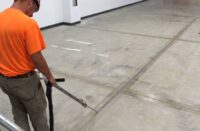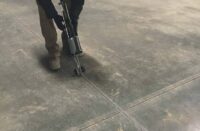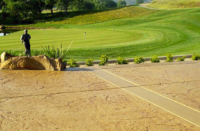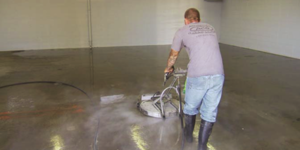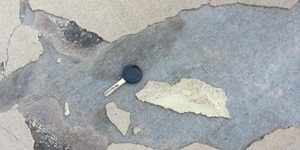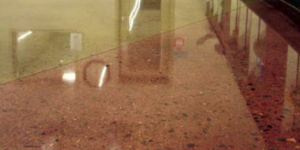In direct contrast to what they say at the start of every episode of the Discovery Channel show “MythBusters,” I consider all of you professionals, and I DO want you to try this at home. Today’s segment looks at some of the most common myths, mistakes, and just plain wrong practices the decorative concrete industry has embraced as commonplace.
I can see where some of these problematic practices came from, while others, I can only surmise, made their way into common practice after years of being passed from one installer to another without much thought as to why we do this or if it really works. I admit that at one time or another I have myself fallen victim to mob psychology and what seems like a common-sense approach, only to scratch my head later on when things just did not turn out as expected. This is where you need to start asking the right questions, taking the time to understand the products and processes you use, and never accept an answer just because someone else said it works.
Myths about muriatc acid
If I offered you a concrete cleaning and preparation product that could kill you if you drank it, blind you if it got in your eyes, leave you on a ventilator if you breathed its fumes, and would give you third-degree burns if it touched your skin, would you use it? Then someone please tell me why hydrochloric acid is the go-to cleaning product of choice in the concrete industry.
Don’t get me wrong, there are times when hydrochloric acid, also known by its trade name muriatic acid, is the right product for the job, but those are few and far between. I recommend using diluted acid (maximum 20 to 1 with water) for surface preparation and to remove inorganic contamination from concrete – that’s it! The idea that acid should be used to clean release powder from stamped concrete or to prepare concrete prior to acid staining is just wrong, and the poor results and failures are the proof. It’s actually quite amazing how well soap, water and a good old-fashioned scrubbing work, and none of those will put you in the hospital.
The other “must” when dealing with acid is neutralization afterward. Any time acid is applied to concrete, no matter how dilute, a proper neutralizing wash must follow. This involves scrubbing with an alkaline soap – not baking soda (more on this in the next section) – followed by a clean water rinse. To cover all your bases, anytime acid is used, take all the proper safety precautions – glasses, gloves, and clothes.
Baking soda myths
Of all the poor practices that the decorative concrete industry engages in, using baking soda to clean up after acid staining takes the prize. Baking soda is great for baking, but terrible for neutralizing and cleaning concrete. What most don’t realize is that baking soda mixed with water makes a mild cleaner – which is nothing that is going to do much to neutralize concrete with acid stain residue strewn about.
The other issue with baking soda is that is tends to leave a white residue on the concrete, only adding to the mess you need to clean up.
If you are using acid on concrete, you need an alkaline soap to neutralize the surface. Alkaline soaps not only register high on the pH scale, but also contain soap or surfactant, which add additional cleaning properties to concrete. If you don’t have access to an alkaline soap, you are better off using 5 gallons of water, 2 cups of household ammonia or bleach, and a few good squirts of dishwashing detergent. For future reference, use baking soda in soda bread, toothpaste and your fridge, not to clean acid-stained floors.
While we are on the topic of cleaning, let’s talk power washers. I am all about making life easier – work smarter, not harder, the saying goes. All that being said, power washers should not be used anytime concrete needs to be cleaned. It seems that the standard answer for any concrete cleaning job is the power washer. Almost every concrete contractor I know owns one, sometimes more than one. The thing we all need to realize is that water is being driven into the concrete at upwards of 2,000-plus psi, which means it is penetrating that much deeper into the concrete, requiring that much longer of a dry time before sealing, overlaying, or whatever next step is planned. The other key factor often overlooked is that a 4,000-psi power washer will win the battle over 3,000-psi concrete every time. There is no easy way to fix power-washer induced profile marks in concrete. Do yourself and your checkbook a favor. Turn down the power on the power washer, or consider using some soap and good old-fashioned elbow grease.
Misapplied sealers
Switching gears, let’s look at another area of the decorative industry that often falls victim to myths and mistakes. Sealers or the art of sealing decorative concrete remains a place where more mistakes occur than any other. If you remember one thing from this article, let it be this: Sealers are not paint, so don’t apply them like paint. Sealers are designed to go down thin. By thin, I mean paper thin. Too often sealers are applied as if they were paint. This is a recipe for major problems. Maybe not today or tomorrow, but sealers applied too heavy WILL fail at some time down the road. Here is an easy exercise that I have used for years when teaching classes on decorative sealers. Take a piece of any rope, cord or twine and cut it to an 80-foot length. Tie the two ends together so you have one big loop. The area inside the loop is 300 square feet, which is the standard coverage for most decorative sealers. If you can’t get one gallon of sealer to cover that entire area, you’re overapplying.
Solvents and sealers don’t mix
Now that we have our sealer down, how do we get it off if needed? Stripping sealers from concrete has to rank up there with root canals, IRS audits, and the first day of school in terms of painful and miserable activities. As with most painful activities, stripping sealers is usually the last resort, but often has to be done. Once the decision is made, make sure you use a chemical stripper, not a solvent. A very common mistake made when stripping sealers is to grab the gallon can of mineral spirits, xylene or acetone, thinking it will do the trick. Those are solvents, of varying strengths, that only liquefy certain sealers for a few minutes. Once the solvent flashes or evaporates, the sealer resolidifies and you’re back to square one. A solvent works well if you’re removing sealer from an area of less than 2 square feet, but with any more area than that, you need a chemical stripper. A chemical stripper actually destroys the sealer coating, turning it into sludge that sits and waits until you get around to scraping or shoveling it off the concrete. Using a chemical stripper allows you to cover larger areas, use less material, and get more of the sealer off the surface. The other advantage is that new green and environmentally friendly technologies in chemical strippers make the handling and cleanup that much easier.
We have covered a few common misunderstandings, mistakes and myths that seem to permeate our industry. Hopefully this has enlightened some of you who may have been operating under false information. In other cases, I hope the information gathered from others’ mistakes saves some of you the pain of repeating those errors. Either way, I encourage you all to use the information to your benefit, and to the benefit of others in our industry.
